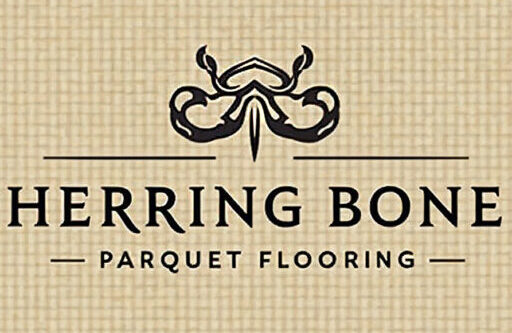
🌳 Introduction: Why Oak and Herringbone Are a Perfect Match
When homeowners or designers seek the ideal balance of elegance, durability, and versatility, oak herringbone parquet flooring consistently rises to the top. Combining the warm, organic texture of oak with the timeless sophistication of the herringbone pattern, this flooring style bridges old-world charm with modern functionality.
Whether you’re restoring a vintage brownstone, upgrading a minimalist loft, or adding flair to a new build, oak herringbone parquet can transform your space from standard to stunning.
But what exactly makes this flooring option so special—and is it the right choice for your needs?
Let’s dive in.
🪵 What Is Oak Herringbone Parquet Flooring?
To understand why oak herringbone is so popular, let’s break it down:
- Oak is a hardwood species known for its:
- High durability and wear resistance
- Attractive grain patterns
- Easy stainability
- Compatibility with various finish options
- Herringbone is a zig-zag laying pattern where rectangular blocks meet at a 90° angle, creating a “V” shaped motif across the floor.
When combined, oak and herringbone deliver a premium flooring option that’s not only eye-catching but also highly functional.
🏠 Where Does Oak Herringbone Flooring Work Best?
Because of its visual complexity and strong materials, oak herringbone can elevate almost any type of space, including:
| Space Type | Benefit |
|---|---|
| Living Rooms | Adds warmth and luxury |
| Dining Areas | Enhances formal aesthetics |
| Entryways & Hallways | Creates a bold first impression |
| Bedrooms | Provides cozy, natural texture |
| Retail or Boutique Stores | Offers upscale feel & client appeal |
| Offices | Adds professional sophistication |
Whether in residential or commercial settings, oak herringbone parquet holds its own in both high-traffic and decorative environments.
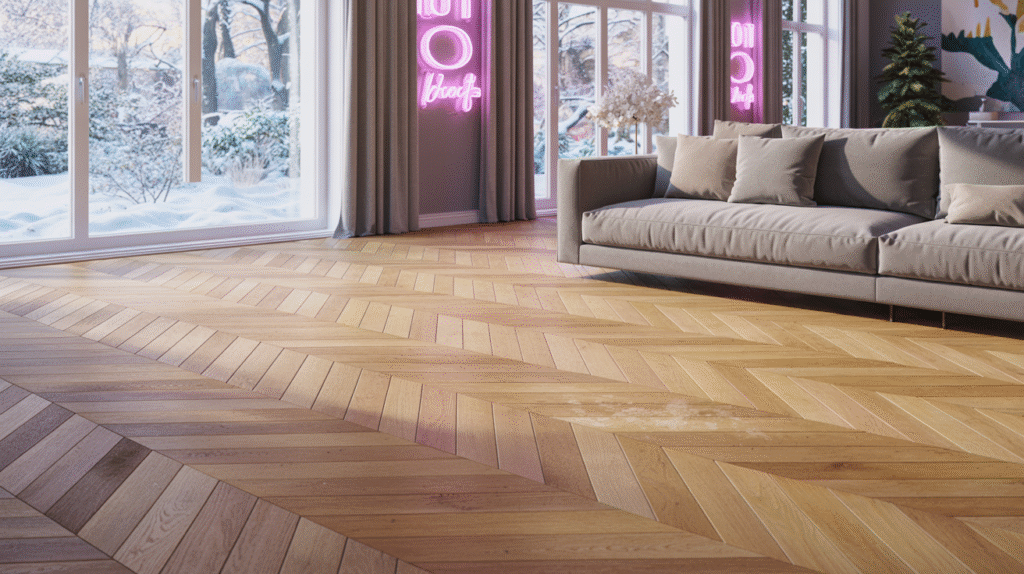
🌈 Oak Color Variations: Picking the Right Tone
One of the major appeals of oak flooring is its wide range of natural hues and finishes. Some popular variations include:
1. Natural Oak
- Light golden tones
- Subtle grain
- Works great in Scandinavian or minimalist spaces
2. Whitewashed Oak
- Pale gray and ivory highlights
- Coastal or rustic chic interiors
3. Smoked Oak
- Rich, dark brown with warm undertones
- Luxurious, dramatic rooms
4. Stained Oak
- Custom colors from honey to walnut
- Matches cabinetry or other woodwork
5. Brushed Oak
- Enhanced grain texture
- Modern rustic appearance
Each finish can drastically change the atmosphere of a room, so choosing wisely is essential. You’ll want to consider lighting, wall color, and furnishings when selecting your tone.
🧱 Solid vs Engineered Oak Herringbone
Oak herringbone parquet comes in two structural types: solid and engineered. Here’s how they differ:
| Feature | Solid Oak | Engineered Oak |
|---|---|---|
| Structure | One solid piece of oak | Oak veneer over plywood/core layers |
| Stability | Less dimensionally stable | More resistant to moisture & temp |
| Underfloor Heating | Not recommended | Yes, ideal for radiant systems |
| Sanding & Refinishing | 4–6 times possible | 1–3 times depending on veneer thickness |
| Price | More expensive | More affordable in most cases |
💡 Pro Tip: For areas prone to moisture or temperature swings (like basements or kitchens), engineered oak herringbone is the safer choice.
🔩 Surface Finish Options
Once you’ve chosen your oak style and structure, the next decision is: how do you want it to look and feel underfoot?
Here are common finish types:
🧴 Lacquered
- Smooth, shiny surface
- High durability
- Easy maintenance
- Slightly more slippery
🛡️ Oiled
- Matte, natural appearance
- Penetrates wood for deep protection
- Requires regular re-oiling
🌿 Hardwax Oil
- Hybrid option with a natural look and topcoat protection
- Balanced maintenance and aesthetics
Your choice will depend on your lifestyle:
- Busy family with pets/kids? Go lacquer.
- Design-first, low-traffic home? Try oiled or brushed.
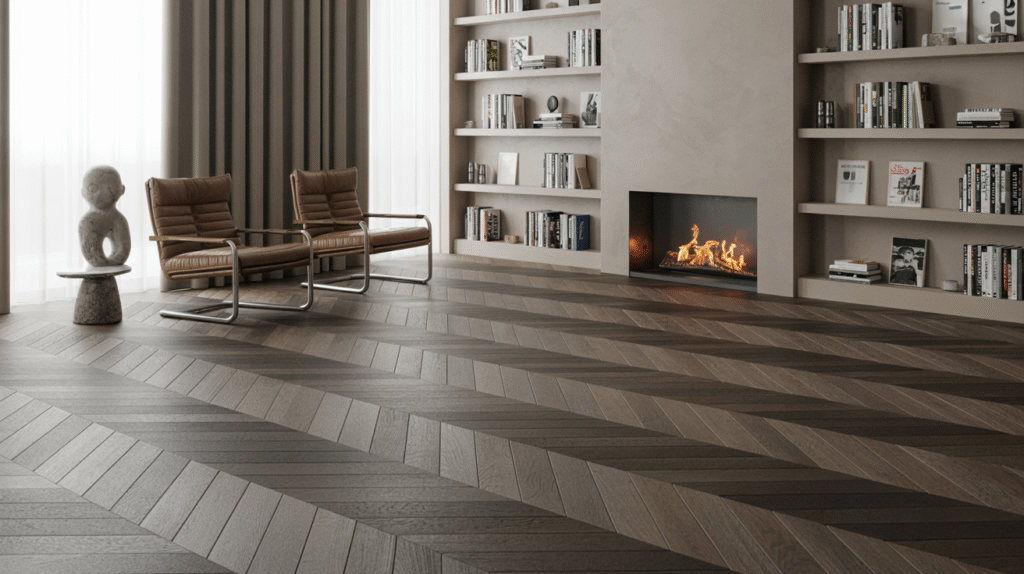
🧰 Preparing for Installation: What You Need to Know
Before a single block of oak hits the subfloor, proper preparation is crucial to ensure a smooth, long-lasting installation.
🔍 Subfloor Conditions and Inspection
Oak herringbone, whether solid or engineered, demands a clean, flat, dry subfloor. Here’s a checklist:
✅ Check for:
- Level surface – no dips or rises greater than 2–3mm over 2 meters
- Cleanliness – sweep or vacuum dust, nails, adhesives
- Moisture – use a moisture meter:
- Concrete: ≤ 3% CM
- Wood: ≤ 10–12% moisture content
- Structural integrity – make sure subfloor is stable and doesn’t squeak
If installing over concrete, apply a damp-proof membrane or vapor barrier primer. Over timber, check for rot or loose boards.
⚙️ Tools and Materials Checklist
Here’s what you’ll typically need:
Materials:
- Oak herringbone parquet blocks (plus 10% extra for cuts and waste)
- Adhesive (polyurethane or MS polymer recommended)
- Moisture barrier or underlay
- Expansion spacers
- Finishing products (oil, lacquer, filler if unfinished)
Tools:
- Mitre saw or table saw
- Notched trowel
- Chalk line or laser guide
- Carpenter’s square
- Rubber mallet
- Tape measure
- Spirit level
- Flooring roller
- Vacuum cleaner
📏 Layout and Centerline Planning
The iconic herringbone pattern demands precision. Start by:
- Measuring the room and snapping chalk lines to define a central axis
- Deciding the direction of the pattern:
- Toward windows for natural light emphasis
- Along the length of a room to elongate the space
- Dry-laying a few blocks to test layout and spacing
📌 Pro Tip: Use a temporary batten to guide the first rows and ensure symmetry.
🧴 Adhesive Application Techniques
Oak is dense and reacts to moisture, so use a high-quality adhesive suitable for wood parquet. Apply:
- Evenly across 1–2 m² at a time using a notched trowel
- Only as much as can be laid within 15–20 minutes
- With care not to over-glue (can seep between joints)
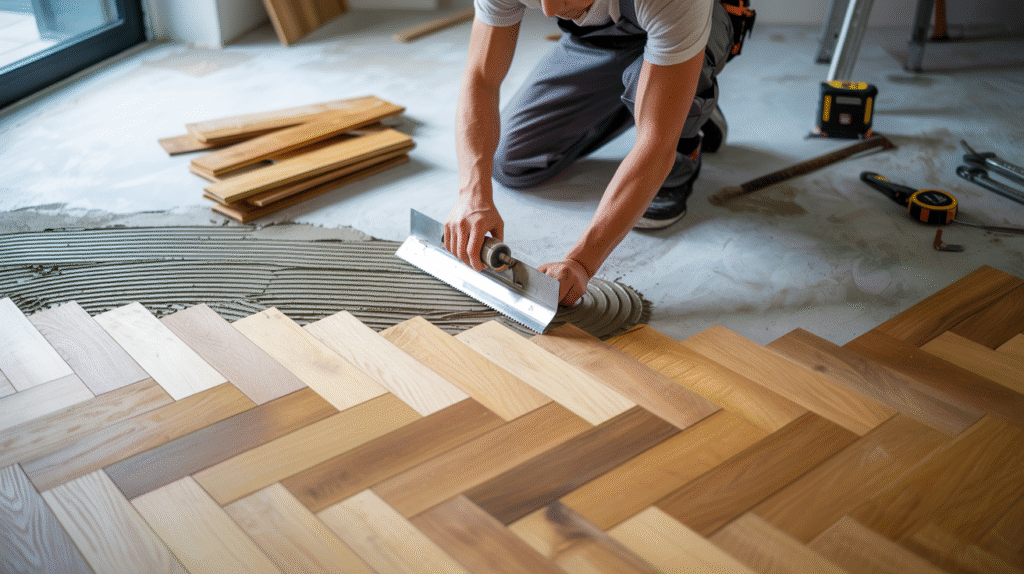
🧱 Laying the Herringbone Blocks
Start from your centerline or batten:
- Lay the first two blocks at a 90° angle to form the “V”
- Use spacers to maintain expansion gaps
- Tap blocks gently into place using a rubber mallet
- Continually check alignment using a straightedge
- Work in small sections and clean any adhesive overflow immediately
As you move outwards from the center, the pattern should remain symmetrical. Errors in the beginning can amplify across the floor—so patience is key.
✂️ Cutting and Fitting Perimeter Blocks
Once the main pattern is laid:
- Use a mitre saw to trim edge blocks to fit walls
- Maintain a consistent 10–15mm expansion gap
- Dry-fit complex cuts before applying glue
- Use filler or trim for any unsightly edge gaps
🚪 Special Considerations for Doors and Obstacles
Door frames, radiator pipes, and built-in cabinetry require custom cuts:
- Radiator pipes: Use a hole saw and a matching “V” cut to fit around the pipe
- Door jambs: Undercut the frame and slide the wood beneath for a seamless look
- Floor transitions: Use threshold strips or reducer profiles where herringbone meets tile or carpet
⚖️ Pros and Cons of Oak Herringbone Parquet Flooring
Like all flooring choices, oak herringbone has strengths and trade-offs. Here’s a detailed look at both sides to help you make an informed decision.
✅ Pros
1. Visual Appeal
Oak herringbone offers a luxurious and eye-catching geometric design. It:
- Adds depth and dimension to small or large spaces
- Elevates even the simplest interior
- Creates a sense of craftsmanship and heritage
2. Durability
Thanks to oak’s dense grain and strength:
- Resists wear in high-traffic areas
- Handles furniture movement and footfall well
- Can last decades with proper care
3. Versatility in Design
It fits:
- Modern minimalist spaces
- Classic and traditional interiors
- Eclectic or transitional styles
You can customize with stains, finishes, or even combine oak tones for contrast.
4. Increases Property Value
Buyers often associate herringbone parquet with luxury, boosting your home’s visual and real-estate appeal.
5. Sustainable Option
Oak, especially from FSC-certified forests, is a renewable, biodegradable, and eco-conscious material when sourced responsibly.
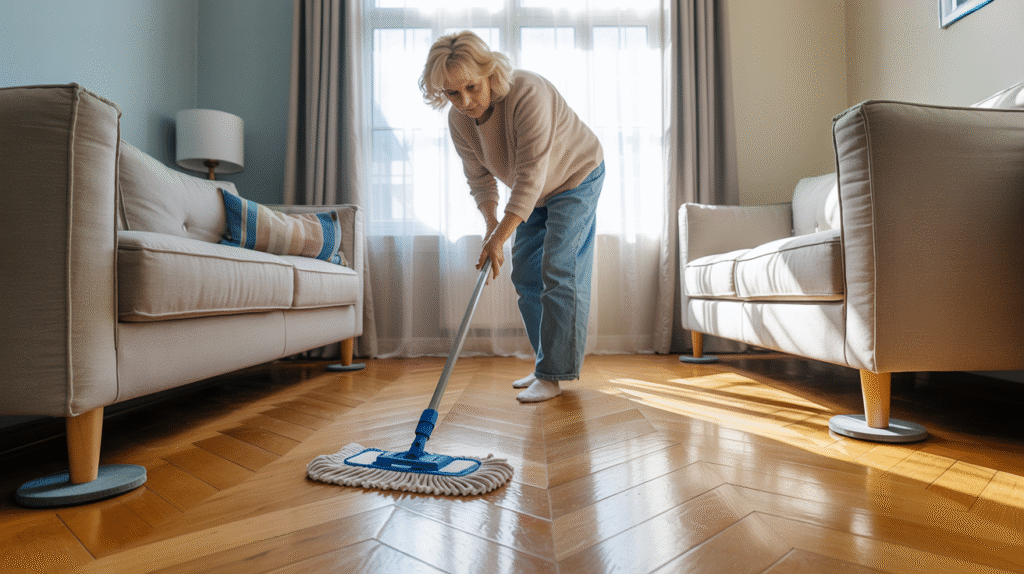
❌ Cons
1. Higher Installation Cost
Due to the intricate pattern and extra cutting:
- Labor is more expensive than standard plank flooring
- Requires skilled professionals or advanced DIY knowledge
2. More Time-Consuming
Installation can take 2–3 times longer than regular flooring, especially in large rooms or non-rectangular layouts.
3. Pattern Imperfections Are Obvious
Any mistake—misaligned block, uneven spacing, or improper cuts—will be noticeable due to the visual nature of herringbone.
4. Cost of Materials
Compared to budget laminate or vinyl, high-quality oak herringbone parquet is more expensive upfront.
💸 How Much Does Oak Herringbone Flooring Cost?
🧾 Estimated Cost Breakdown (per square meter):
| Item | Cost Range |
|---|---|
| Engineered oak blocks | $40 – $80 |
| Solid oak blocks | $60 – $120 |
| Adhesive and materials | $5 – $10 |
| Professional installation | $30 – $50 |
| Sanding & finishing (raw) | $8 – $15 |
💡 For a 25m² room, total installation can range from $2,000 to $5,000+, depending on material quality and labor costs.
🔧 Maintenance and Long-Term Care
Oak is tough—but it still needs some love to retain its natural charm.
Daily & Weekly Maintenance
- Sweep or vacuum with a soft bristle or hardwood-safe attachment
- Mop with a slightly damp microfiber cloth (never soaking wet!)
- Clean spills immediately to avoid staining
Long-Term Protection
- Use door mats at entrances to trap grit
- Apply felt pads under furniture legs
- Refrain from dragging heavy objects across the floor
🔁 Refinishing Options
One of the biggest perks of oak parquet is that it can be refinished multiple times, especially solid oak.
When to Refinish:
- Dull appearance or surface scratches
- Discoloration from sun or water
- Loss of protective top layer
Process:
- Sand down the top surface (if thickness allows)
- Apply fresh oil, lacquer, or hard wax
- Buff and let cure
Engineered oak with thick wear layers can also be refinished once or twice depending on depth.
🏡 Real-Life Use Cases
🛋️ Modern Apartment
A New York-based couple installed smoked oak herringbone in their open-plan apartment. Combined with matte-black accents and neutral walls, the result was sophisticated yet cozy.
🏰 Historical Home Renovation
A 19th-century London townhouse used whitewashed oak herringbone to refresh classic rooms while maintaining historical integrity.
🏢 Office Lobby Upgrade
A creative agency in San Francisco used engineered brushed oak herringbone in its reception to combine professionalism with modern flair.
🎨 Styling Tips: Making Oak Herringbone Shine
Oak herringbone flooring is more than a functional surface—it’s a design feature. Here’s how to style it for maximum impact:
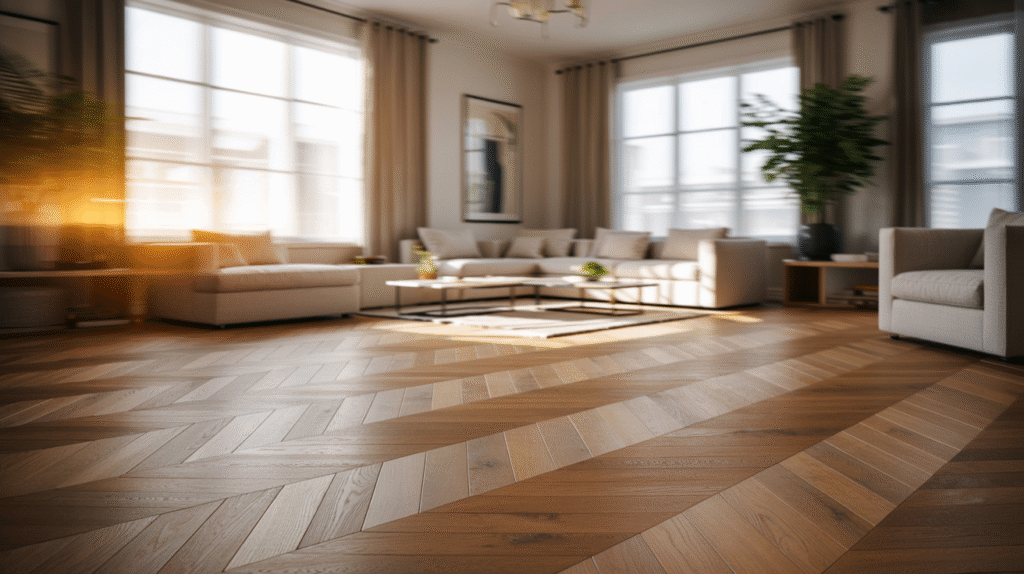
🪟 Let the Light Work
Position the pattern so that natural light runs along the grain and edges of the “V” shape. This highlights texture and brings depth to the room.
🪑 Furniture Pairings
- Mid-century modern: Let warm oak contrast with teak or walnut pieces
- Minimalist: Use light oak with white walls and clean silhouettes
- Traditional: Pair dark oak herringbone with heavy drapes, chandeliers, and vintage furniture
Use area rugs sparingly to frame zones without covering too much of the pattern.
🖼️ Wall Colors That Complement
- Light oak floors: Contrast with navy, charcoal, or forest green walls
- Dark oak floors: Match with ivory, sand, or cool grays
- Whitewashed oak: Blend with coastal blues or sage tones
Consistency between floor and wall colors creates visual harmony.
🧱 Add Texture and Contrast
- Use matte finishes to balance the natural shine of lacquered floors
- Consider pairing oak herringbone with industrial elements—exposed beams, metal fixtures, concrete walls—for a modern twist
🚪 Transition Thoughtfully
When oak herringbone meets tile, carpet, or vinyl in another room:
- Use brass or wood reducers
- Keep transitions level and clean to preserve the visual rhythm
✅ Final Thoughts: Is Oak Herringbone Right for You?
Oak herringbone parquet flooring brings together durability, timeless elegance, and design flexibility. Whether you’re installing it in a cozy home office, a spacious kitchen, or a chic retail space, its appeal is undeniable.
Here’s a quick recap:
| Benefit | Why It Matters |
|---|---|
| Visual appeal | Instantly elevates interiors |
| Long-lasting material | Handles heavy use and refinishing |
| Design flexibility | Works with modern, classic, rustic styles |
| Resale value | Highly desirable to potential buyers |
| Maintenance simplicity | Easy care routines, few special tools needed |
If you’re looking for a floor that will age gracefully, reflect personal style, and offer high performance, oak herringbone is an investment that pays off in beauty and function.
🧠 Summary Checklist
Before you commit to oak herringbone parquet flooring, ask yourself:
- Have I chosen between solid and engineered options?
- Do I have the right subfloor preparation plan?
- Am I going with natural, brushed, or stained oak?
- Will I DIY or hire a professional installer?
- Do I understand the long-term maintenance needs?
If you answered “yes” to most of these—congratulations, you’re ready to transform your space.
